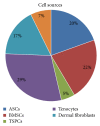Decellularized and Engineered Tendons as Biological Substitutes: A Critical Review
- PMID: 26880985
- PMCID: PMC4736572
- DOI: 10.1155/2016/7276150
Decellularized and Engineered Tendons as Biological Substitutes: A Critical Review
Abstract
Tendon ruptures are a great burden in clinics. Finding a proper graft material as a substitute for tendon repair is one of the main challenges in orthopaedics, for which the requirement of a biological scaffold would be different for each clinical application. Among biological scaffolds, the use of decellularized tendon-derived matrix increasingly represents an interesting approach to treat tendon ruptures. We analyzed in vitro and in vivo studies focused on the development of efficient protocols for the decellularization and for the cell reseeding of the tendon matrix to obtain medical devices for tendon substitution. Our review considered also the proper tendon source and preclinical animal models with the aim of entering into clinical trials. The results highlight a wide panorama in terms of allogenic or xenogeneic tendon sources, specimen dimensions, physical or chemical decellularization techniques, and the cell type variety for reseeding from terminally differentiated to undifferentiated mesenchymal stem cells and their static or dynamic culture employed to generate implantable constructs tested in different animal models. We try to identify the most efficient approach to achieve an optimal biological scaffold for biomechanics and intrinsic properties, resembling the native tendon and being applicable in clinics in the near future, with particular attention to the Achilles tendon substitution.
Figures






Similar articles
-
The trend of allogeneic tendon decellularization: literature review.Cell Tissue Bank. 2024 Mar;25(1):357-367. doi: 10.1007/s10561-023-10097-x. Epub 2023 Jun 24. Cell Tissue Bank. 2024. PMID: 37355504 Review.
-
Decellularization of Large Tendon Specimens: Combination of Manually Performed Freeze-Thaw Cycles and Detergent Treatment.Methods Mol Biol. 2018;1577:227-237. doi: 10.1007/7651_2017_49. Methods Mol Biol. 2018. PMID: 28702884
-
Human hamstring tenocytes survive when seeded into a decellularized porcine Achilles tendon extracellular matrix.Connect Tissue Res. 2013;54(4-5):305-12. doi: 10.3109/03008207.2013.820283. Epub 2013 Aug 23. Connect Tissue Res. 2013. PMID: 23815278
-
The Tissue-Engineered Tendon-Bone Interface: In Vitro and In Vivo Synergistic Effects of Adipose-Derived Stem Cells, Platelet-Rich Plasma, and Extracellular Matrix Hydrogel.Plast Reconstr Surg. 2017 Dec;140(6):1169-1184. doi: 10.1097/PRS.0000000000003840. Plast Reconstr Surg. 2017. PMID: 28806294
-
Decellularized tendon as a prospective scaffold for tendon repair.Mater Sci Eng C Mater Biol Appl. 2017 Aug 1;77:1290-1301. doi: 10.1016/j.msec.2017.03.279. Epub 2017 Mar 31. Mater Sci Eng C Mater Biol Appl. 2017. PMID: 28532007 Review.
Cited by
-
A new decellularized tendon scaffold for rotator cuff tears - evaluation in rabbits.BMC Musculoskelet Disord. 2020 Oct 17;21(1):689. doi: 10.1186/s12891-020-03680-w. BMC Musculoskelet Disord. 2020. PMID: 33069236 Free PMC article.
-
Independent, Controllable Stretch-Perfusion Bioreactor Chambers to Functionalize Cell-Seeded Decellularized Tendons.Ann Biomed Eng. 2020 Mar;48(3):1112-1126. doi: 10.1007/s10439-019-02257-6. Epub 2019 Apr 8. Ann Biomed Eng. 2020. PMID: 30963381 Free PMC article.
-
Comprehensive ex vivo and in vivo preclinical evaluation of novel chemo enzymatic decellularized peripheral nerve allografts.Front Bioeng Biotechnol. 2023 Mar 30;11:1162684. doi: 10.3389/fbioe.2023.1162684. eCollection 2023. Front Bioeng Biotechnol. 2023. PMID: 37082209 Free PMC article.
-
Biomaterial Properties and Differentiation Strategies for Tenogenic Differentiation of Mesenchymal Stem Cells.Cells. 2025 Mar 18;14(6):452. doi: 10.3390/cells14060452. Cells. 2025. PMID: 40136701 Free PMC article. Review.
-
Cell-derived decellularized extracellular matrices.Methods Cell Biol. 2018;143:97-114. doi: 10.1016/bs.mcb.2017.08.007. Epub 2017 Nov 2. Methods Cell Biol. 2018. PMID: 29310794 Free PMC article.
References
-
- Andarawis-Puri N., Ricchetti E. T., Soslowsky L. J. Interaction between the supraspinatus and infraspinatus tendons: effect of anterior supraspinatus tendon full-thickness tears on infraspinatus tendon strain. American Journal of Sports Medicine. 2009;37(9):1831–1839. doi: 10.1177/0363546509334222. - DOI - PMC - PubMed
Publication types
LinkOut - more resources
Full Text Sources
Other Literature Sources

